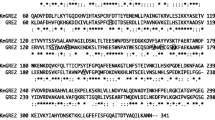Abstract
A novel aldo–keto reductase gene, Tm1743, from Thermotoga maritima was overexpressed in Escherichia coli. The enzyme displayed the highest activity at 90 °C and at pH 9. It retained 63 % of its activity after 15 h at 85 °C. The enzyme also could tolerate (up to 10 % v/v) acetonitrile, ethanol and 2-propanol with slightly increased activities. Methanol, DMSO and acetone decreased activity slightly. Furthermore, Tm1743 exhibited broad substrate specificity towards various keto esters, ketones and aldehydes, with relative activities ranging from 2 to 460 % compared to the control. Its optimum substrate, 2,2,2-trifluoroacetophenone, was asymmetrically reduced in a coupled NADPH-regeneration system with an enantioselectivity of 99.8 % and a conversion of 98 %.



Similar content being viewed by others
References
Asako H, Shimizu M, Itoh N (2008) Engineering of NADPH-dependent aldo–keto reductase from Penicillium citrinum by directed evolution to improve thermostability an enantioselectivity. Appl Microbiol Biotechnol 80:805–812
Ellis EM (2002) Microbial aldo–keto reductases. FEMS Microbiol Lett 216:123–131
Huber R, Langworthy TA, König H, Thomm M, Woese CR, Sleytr UB, Stetter KO (2005) Thermotoga maritima sp. nov. represents a new genus of unique extremely thermophilic eubacteria growing up to 90 °C. Arch Microbiol 144:324–333
Iwase M, Kurata N, Ehana R, Nishimura Y, Masamoto T, Yasuhara H (2006) Evaluation of the effects of hydrophilic organic solvents on CYP3A-mediated drug–drug interaction in vitro. Hum Exp Toxicol 25:715–721
Jez JM, Bennett MJ, Schlegel BP, Lewis M, Penning TM (1997) Comparative anatomy of the aldo–keto reductase superfamily. Biochem J 326:625–636
Jin Y, Penning TM (2007) Aldo–keto reductases and bioactivation/detoxication. Annu Rev Pharmacol Toxicol 47:263–292
Machielsen R, Uria AR, Kengen SWM, Oost J (2006) Production and characterization of a thermostable alcohol dehydrogenase that belongs to the aldo–keto reductase superfamily. Appl Environ Microbiol 72:233–238
Matsuda T, Yamanaka R, Nakamura K (2009) Recent progress in biocatalysis for asymmetric oxidation and reduction. Tetrahedron Asymmetry 20:513–557
Nelson KE, Clayton RA, Gill SR, Gwinn ML, Dodson RJ, Haft DH, Hickey EK et al (1999) Evidence for lateral gene transfer between archaea and bacteria from genome sequence of Thermotoga maritima. Nature 399:323–329
Ni Y, Li CX, Ma HM, Zhang J, Xu JH (2011) Biocatalytic properties of a recombinant aldo–keto reductase with broad substrate spectrum and excellent stereoselectivity. Appl Microbiol Biotechnol 89:1111–1118
Richter N, Hummel W (2011) Biochemical characterisation of a NADPH-dependent carbonyl reductase from Neurospora crassa reducing α- and β-keto esters. Enzyme Microb Technol 48:472–479
Schweiger P, Gross H, Deppenmeier U (2010) Characterization of two aldo–keto reductases from Gluconobacter oxydans 621H capable of regio- and stereoselective α-ketocarbonyl reduction. Appl Microbiol Biotechnol 87:1415–1426
Vieille C, Zeikus GJ (2001) Hyperthermophilic enzymes: sources, uses, and molecular mechanisms for thermostability. Microbiol Mol Biol Rev 65:1–43
Wierenga RK (2001) The TIM-barrel fold: a versatile framework for efficient enzymes. FEBS Lett 492:193–198
Willies S, Isupov M, Littlechild J (2010) Thermophilic enzymes and their applications in biocatalysis: a robust aldo-keto reductase. Environ Technol 31:1159–1167
Acknowledgments
This work was supported by a project (20101131N06) from the Science & Technology Department of Hangzhou, China.
Author information
Authors and Affiliations
Corresponding author
Electronic supplementary material
Below is the link to the electronic supplementary material.
Rights and permissions
About this article
Cite this article
Ma, YH., Lv, DQ., Zhou, S. et al. Characterization of an aldo–keto reductase from Thermotoga maritima with high thermostability and a broad substrate spectrum. Biotechnol Lett 35, 757–762 (2013). https://doi.org/10.1007/s10529-013-1141-6
Received:
Accepted:
Published:
Issue Date:
DOI: https://doi.org/10.1007/s10529-013-1141-6




